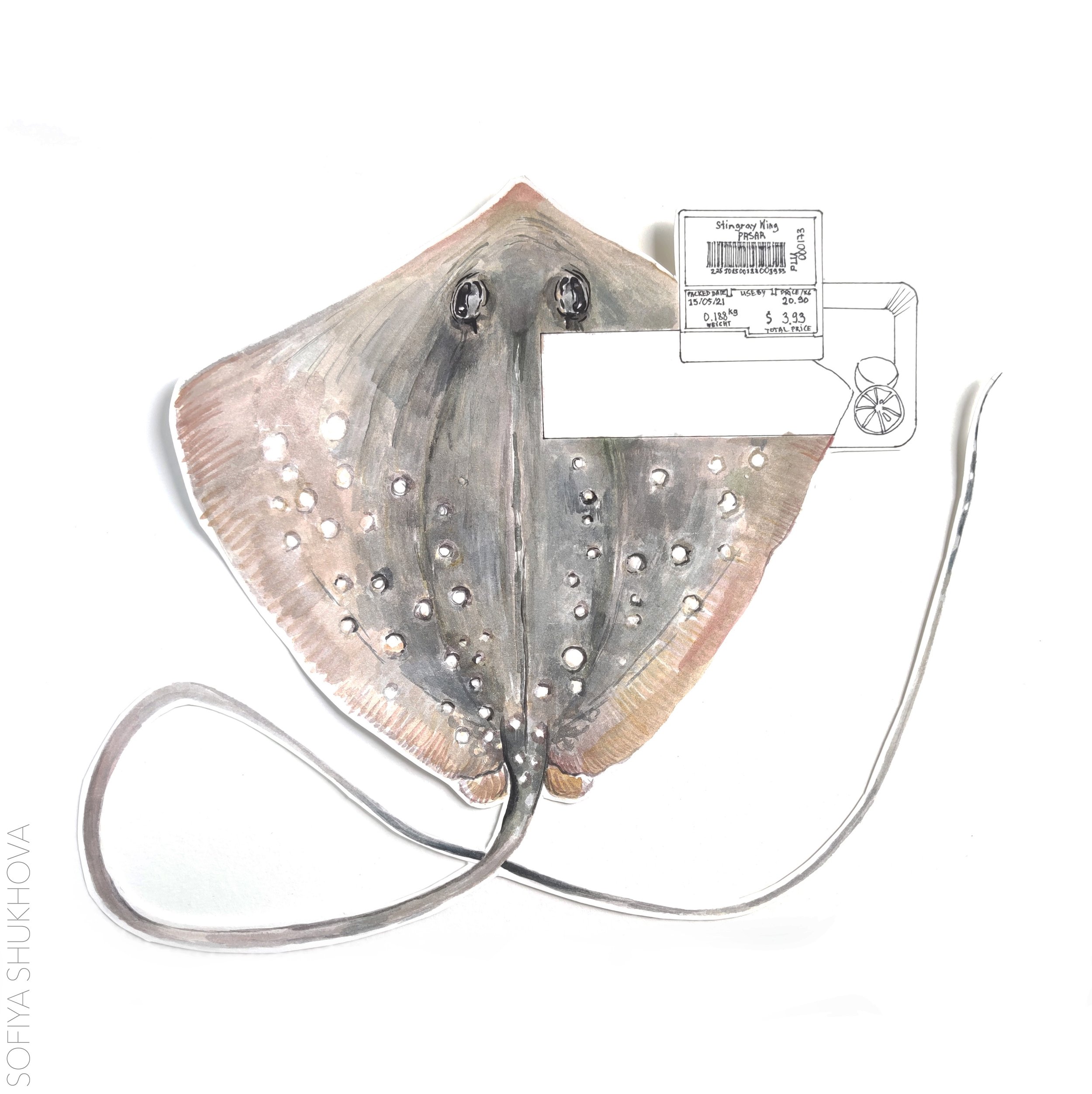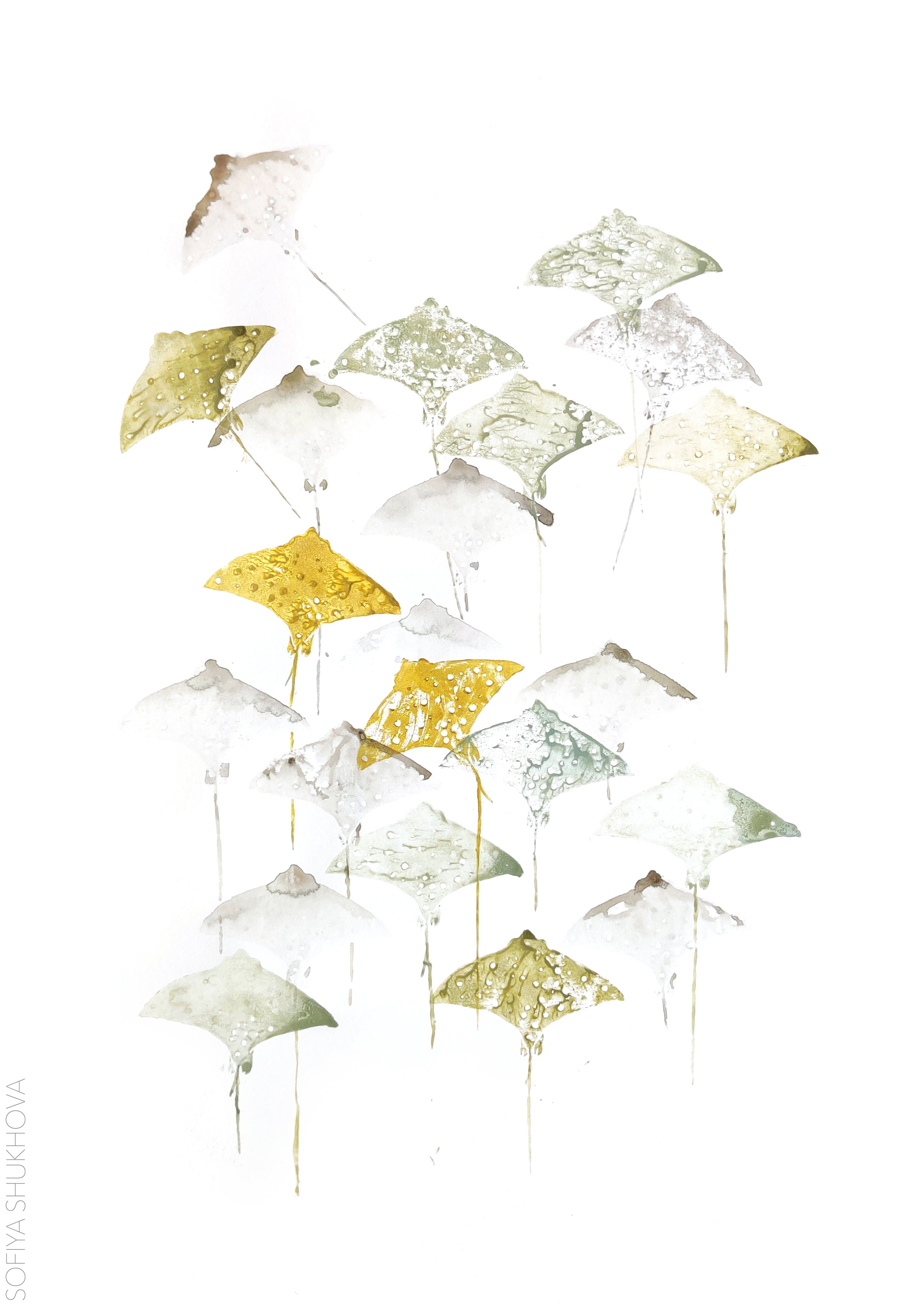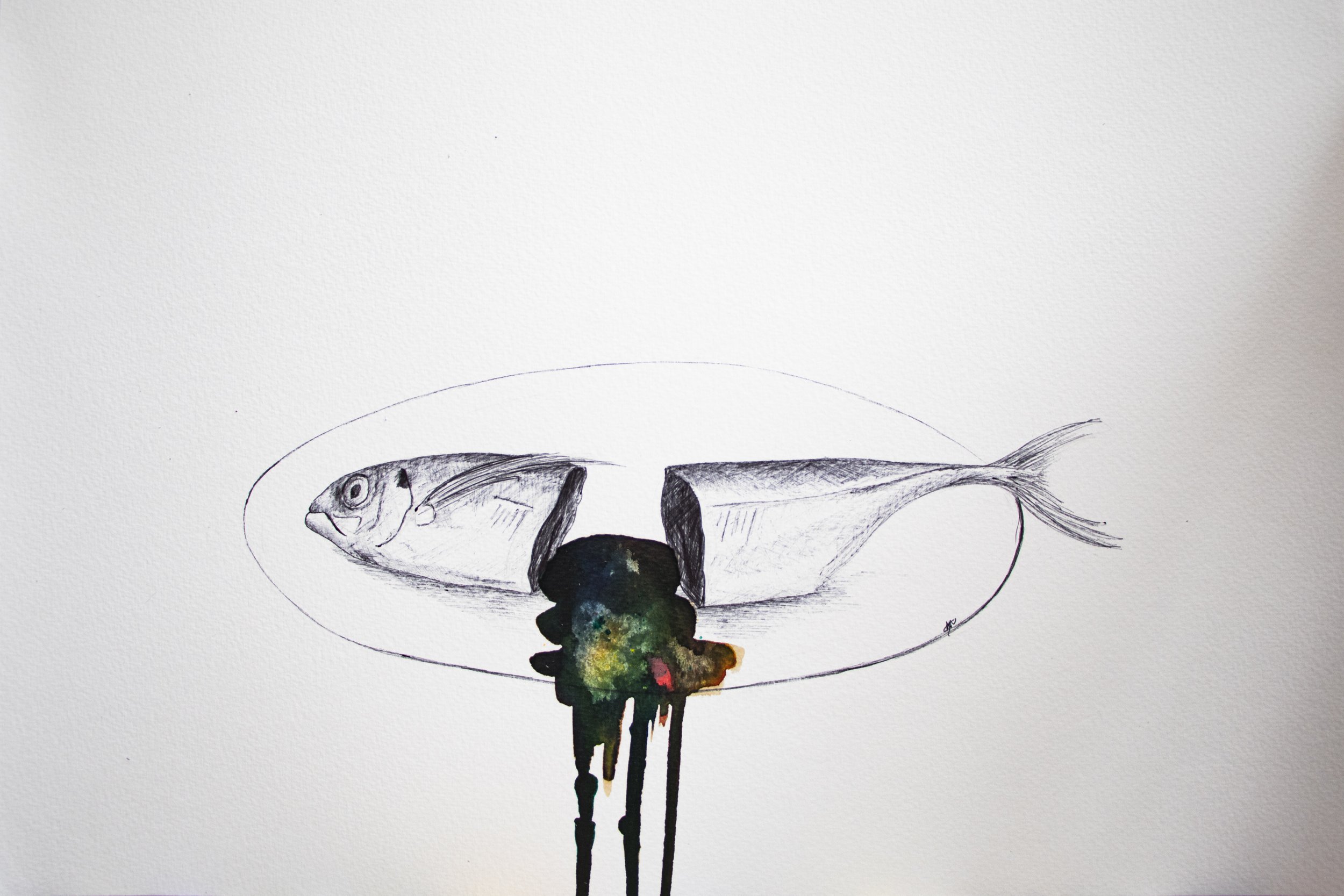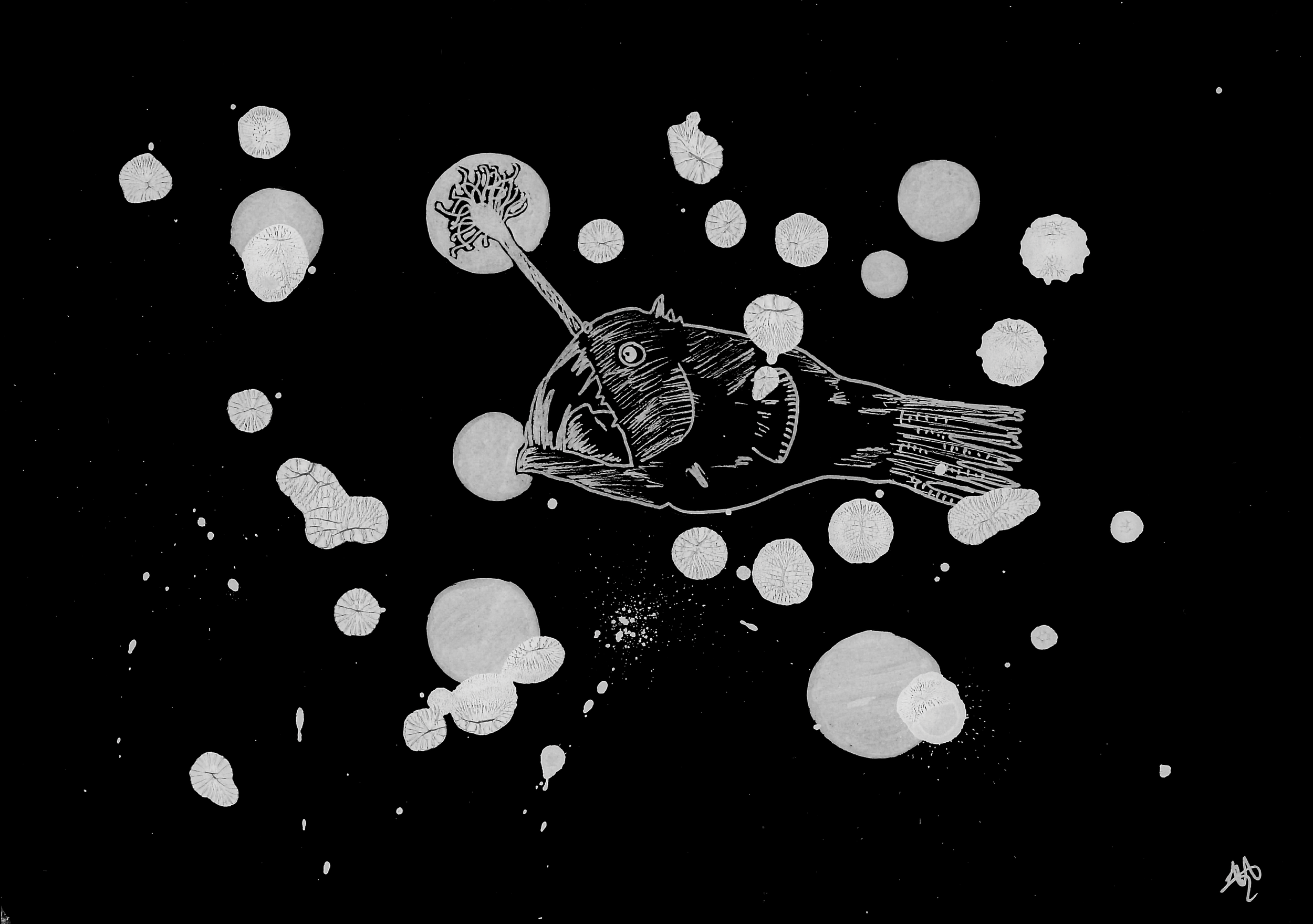Read on as Sofiya Shukhova and Alicia Hayden discuss their artistic vision, process, and what marine “artivism” means to them.
Sofiya Shukhova
Artist
What inspires your wildlife artivism? And what motivates you to create marine wildlife artivism pieces?
Virtually everything inspires me! I work in conservation, so I am constantly surrounded by conservation-related information. I read papers, reports and news about various conservation issues; I follow many conservation and animal welfare projects on social media; I see animals being injured or killed in human-wildlife conflicts. On top of all that, I live in a city where one can easily buy shark or ray meat and a drink containing saiga horn in a supermarket. I encounter things that I want to change or improve all the time, so I try to address at least some of them through my art.
As for marine wildlife artivism, I do not really separate it from my other works. Whatever species or conservation issue inspires me for an art piece, I embark on a journey of researching it and creating art about it.
However, this has not always been the case. I was a bit hesitant to create art featuring marine species in the past. I felt like I had less knowledge about marine conservation compared to other conservation areas. It changed recently when I embarked on a project about rays. The success of my 'Shark Fin' piece and its winning in the Human Impact category of the Wildlife Artist of the Year 2019 also helped. Appreciation of this piece by the public and fellow artists gave me more confidence.
“Shark Fins”
Do you ever approach scientists and work with them to illustrate their research?
Although I did illustrations for two studies that I co-authored, I don’t usually illustrate research. I prefer using scientific works to inspire and inform my art instead. Given that I have a Master of Science degree in Conservation and work experience in the field, I feel confident reading scientific papers and drawing conclusions to inspire my art. However, sometimes reading an article or report or other publications may not be enough. In that case, I reach out to scientists to get more details and clarify any doubts.
My artwork 'Missing piece' draws inspiration from the work of scientists from Singapore who use lego bricks to grow corals in their lab. They build vertical farms where lego pieces provide flat and stable surfaces for young corals to rest and grow. When I started working on the piece inspired by this project, I struggled to find information on the coral species that they grow on, so I had to contact one of the scientists on LinkedIn to get more details. The scientist turned out to be very supportive of my work and answered all my questions very promptly.
“Missing Piece”
What is your favourite marine organism to illustrate, and why?
I don't think I will ever be able to choose one. The beauty is in diversity, and it is also true for marine creatures. Currently, I am working on an art project about rays. It is a collaborative project with a shark and ray scientist, Naomi Clark-Shen, from whom I am learning about stingray biology and ecology, as well as the human impact on their population. Ray conservation is gravely overlooked. Despite the large scale of the ray trade, they are less studied, assessed, and protected than sharks.
By working on this project, I learned about the diversity of ray taxa. There are over 600 identified species of rays, and they all come in different shapes, colours, patterns and sizes. I cannot bear to think that we may lose some of these species, even before properly recording and assessing them. Learning about rays and other non-human creatures is essential for deepening and shaping our understanding of the world and ourselves. Understanding what animals look like, how they move, experience, interact with their own kind and with others can make us humans more conscious about our own relationships with other people, creatures and environment. Once more conscious, we are likely to become kinder, more inclusive and caring.



You also create pieces about terrestrial wildlife; how does the process differ depending on whether your subject is land-based or marine-based?
Honestly, not much. I moved away from creating very detailed, realistic illustrations of species to more conceptual works focusing on conservation topics. So, in that sense, the process is very similar whether I make art about terrestrial or marine species. I get inspired, do research, think about the concept and create.
Having said that, I will admit that it is probably slightly easier for me to play with the form, texture and positioning of terrestrial mammals, reptiles, amphibians, insects and birds than marine creatures. I had more encounters with the animals on land than in the sea, so I am slightly less familiar with the movement and behaviours of certain marine species.
What do you want the general public to take away from your pieces?
I want people to get curious when seeing my works, to start asking questions, learning about conservation issues and, of course, to act. I understand that not everyone will be able to change their behaviour overnight. Still, I hope that my art will contribute to their journey of learning and understanding issues, becoming more informed and caring. I believe that my works and wildlife artivism in general have a better chance to spark a change than 'old-school' wildlife art. Realistic paintings or naturalist illustrations are needed for showing the beauty and diversity of the natural world, but they are not enough for revealing what is wrong with human-other species relationships. I do not care whether my art is pleasing or not to the eyes of the viewers. It is way more important for me to create a piece that grasps attention, sparks curiosity, and leads to a change.
“Ego”
Alicia Hayden
Poet & Artist
Where do you get inspiration for your work?
The natural world! Especially when I’m going for walks around my local area, I tend to dream up artwork and poetry based on what I see around me. For example, I recently created a mini-collection of poems “Tales of the Forgotten Wood”, all of which were written on walks around a magical woodland in Cornwall I visited this summer! I then drew illustrations to accompany the poems based on photos I took while I was there.
Tales of the Forgotten Wood is available to read here: https://aliciahaydenportfolio.wordpress.com/mini-collections/
When creating my wildlife artivism pieces, I am more intrigued and inspired by research about conservation issues. As a biologist, I enjoy researching my topics in scientific papers and journals, before finding a way to communicate this information through art.
When the Whale Sang
How are your drawings and poetry contributing to marine conservation?
I really love drawing marine organisms; I find them so beautiful and satisfying to recreate through my artwork. Marine organisms are also affected by a plethora of threats, which I like trying to represent through wildlife artivism pieces. Wildlife artivism pieces tend to be more powerful than ordinary wildlife art pieces, and often have an explicit message about conservation, aimed at motivating people to change things in their everyday lives, or if that’s not possible, to generate more awareness about the issues faced by marine life, so governments and organisations can trigger change. Some of my favourite marine wildlife artivism pieces include “When the Whale Sang”, which won David Shepherd Wildlife Foundation’s Wildlife Artist of the Year 2021 “Human Impact” category, and was awarded the inaugural Ingrid Beazley Award; as well as “Bottlefish”, “Oily Fish”, and “Who turned on the lights?”



My poetry, like my artwork, varies in the tone it takes about an environmental issue. Some of my pieces are celebratory, whereas others are sadder, and draw attention to the destruction faced by our natural world - such as “The Whale’s Song”, “Plastic Bag”, and “Hitchhiker”. I hope that by varying my tone, different poems will speak to different people, meaning more people become aware of the issues faced by our marine wildlife.
-
The Whale's Song
It sounds a bit like the feeling of watching
honey seep through milk.
A thick, luxurious, gorgeous sound.
A feeling of deep reverberations,
Which echo through a vast, vast
Amphitheatre.
But his stage, once packed with
Kaleidoscope fish and pastel coral,
is an empty shell.
A hollow vessel.
So, he moves on.
And sings to the ocean –
A loneliness you cannot comprehend.
From Rain before Rainbows – Alicia Hayden 2020
-
Plastic Bag
It glides with the current,
Tendrils glistening, stretching, waving.
The turtle reaches up to it –
The first meal it has seen in weeks.
Trapped.
A plastic bag.
The artificial meal.
See-through.
Weightless.
Deadly.
From Rain before Rainbows – Alicia Hayden 2020
-
Hitchhiker
I’ve seen the world, I’m telling you!
Giant humpback whales leaping into the sky
And kelp forests swirling with dark green magic.
Emperor Penguins, like bullets, through the sea
And Marine Iguanas sneezing next to me.
I’ve seen the world, I swear it’s true!
Orcas bubble-netting salmon
And Vampire squid hunting in the depths.
The hot, sandy beaches of Ibiza, Portugal,
Croatia, Italy, and Spain.
I’ve seen the world, but you ask me – how?
How did I travel when I have no means.
Well, and this is the best part,
I clung on to my tiny, bright red, floating boat
And toured the whole of the seven seas.
Notes: This poem is discussing how plastic pollution leads to alien invasive species and harmful bacteria “hitch-hiking” around our oceans.
Alicia Hayden, 2021
What are the main differences between creating visual art and writing about marine wildlife? How does your process change depending on the medium?
I feel like when I write about marine wildlife, I have a bit more flexibility, and can involve more imaginative elements! With visual art, I am constrained by reference images, as I like to make my art as realistic as possible - with poetry, this isn’t the case. Depending on the topic, my poetry is either more whimsical, such as “Urban Hares”, or more hard-hitting, like “Moon, moon, where is the sea?” than my artwork.
“
My brothers and sisters and I are climbing out of our leathered eggs shells.
The full moon will light our way – our journey out to sea.
There are many perils on this journey; creatures which wish to eat us,
Creatures which wish us harm – but we push on, small fins scrabbling.
The moon shines so brightly now – I think it is beautiful.
I think it is getting closer, now.
The sound of the waves seems further away, the sea spray doesn’t touch my shell anymore,
But this must be right – because the moon is closer, closer.
It is so close I can hear strange sounds – perhaps they are the men in the moon,
Or new friends out at sea. My brothers and sisters waiting for me.
…
Too bright.
The light,
It hurts.
My eyes,
Must close.
Moon, moon,
Where is
The sea?”
My process also varies quite significantly! Poems tend to be quite spontaneous - often I think of ideas while I’m on a walk and quickly jot them down; and I tend to write several poems in one sitting. My visual art normally requires significantly more planning before hand - particularly my marine artivism pieces, which I normally brainstorm with my partner and do preliminary sketches of, before creating the final piece!
What are the main challenges in creating art about marine wildlife?
I find that trying to capture movement and the likeness of the species is particularly tricky, especially when I haven’t seen the species in the wild. I like trying to depict the behaviour and character of my wildlife subject, and this is definitely harder when I haven’t seen the species!
One of the other main challenges is selecting the right media for the piece. When working on artwork depicting marine wildlife, I often gravitate towards biro, as it helps replicate their smooth yet surprisingly patterned skin - but for some pieces, I’ve discovered that more liquid media, such as inks, are more effective!
Who Turned on the Lights?
What is your most exciting encounter with marine wildlife, and how has it impacted your work?
Living in the UK means that I haven’t encountered marine wildlife as much as I’d have liked to, so in general my work is more aspirational with regards to subject! Having said this, one of my recent exciting encounters with marine wildlife was watching a pod of common dolphins in Scotland this summer, which inspired me to write a poem and create a small accompanying illustration about their movement. In the future, I would absolutely love to see a humpback whale. I think they are so magnificent and beautiful - so peaceful and omniscient - I would love to see one up close.
Peapods
Peapods
The water is a shining turquoise jewel:
White cappuccino foam lapping against sugar cube rocks.
I gaze out across the rippling surface,
The bubble trails brewing like boiling soup, in the middle of the loch.
Suddenly, they leap!
Dark smudges against a crystal-clear backdrop:
They look like tadpoles, before they’ve developed legs,
Or like dark pea pods – curling strings unfurling behind them,
Just like the bubbles that spurt out of their blowholes.
Perfect spheres – shining, silver orbs.
I watch them move for miles across the loch,
The occasional splash! drifting its way over to me
Across the valley.
They are gone before I’ve fully appreciated them,
Pea pod bodies returning to the soup,
Slipping back under like a ladle in reverse.








